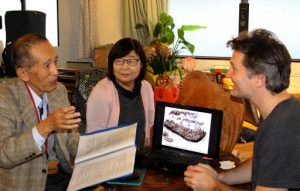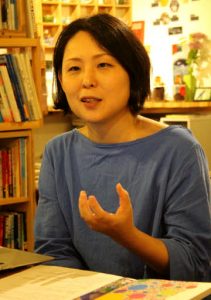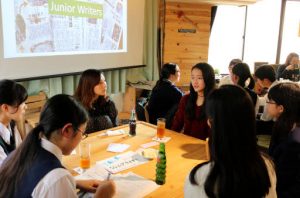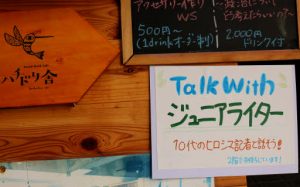Peace Seeds: Teens in Hiroshima Sow Seeds of Peace (Part 62)
Nov. 15, 2018
Sending out messages from the peace café
More than a year has passed since a café called Hachidori-sha (Hummingbird House) opened in a building in Dobashi-cho, Naka Ward, near the Hiroshima Peace Memorial Park. Since then, a variety of events have been held there, such as gatherings to sit together with A-bomb survivors to hear their stories and group discussions about assistance to developing nations and issues involving peace education.
At the Hachidori-sha café, everyone can come together in the cozy, timbered interior to talk casually in a warm, relaxed atmosphere over a cup of tea. With visits by many peace activists and tourists from abroad, the café has become a new hub for a wide range of people, regardless of nationality or age, to join together and send out messages for peace from Hiroshima.
The junior writers of the Chugoku Shimbun interviewed visitors to the café about their work and their thoughts. We also held our own event there.
Conversation helps hand down A-bomb survivors’ experiences
Each month, on days that contain the numeral 6, Hachidori-sha holds an event in which visitors can talk with people who speak about A-bomb experiences. During this time, the visitors sit at the same table with the A-bomb survivors and A-bomb experience “memory keepers” and listen to their stories.
These events have been organized by Erika Abiko, 39, the owner of Hachidori-sha, who became friendly with some A-bomb survivors and came to feel a closer connection to the atomic bombing. She hopes that such events will enable others to gain a similar experience. Because the A-bomb experiences are shared not only in Japanese but also in English, the café has many international visitors, too.
On October 26, when I went there to gather information for this article, So Horie, 78, a resident of Saeki Ward, talked about his A-bomb experience. One visitor who listened to his account with keen interest was Rufus Wyer, a 37-year-old New Yorker who was visiting Hiroshima for the first time. Since the time he learned that his grandfather had been involved in the Manhattan Project, which was established by the United States to develop atomic bombs during World War II, he had long desired to visit Hiroshima one day.
Mr. Wyer heard about Hachidori-sha at the Hiroshima guest house where he was staying and decided to drop by. Mr. Horie was four years old when the atomic bomb was dropped on Hiroshima, and his father was killed in the attack. Later, he lost his siblings to cancer. As Mr. Horie spoke about his experience, Mr. Wyer listened intently, nodding his head and asking questions.
Also on this day, Sakuko Sasaki, 68, a resident of Nishi Ward and an A-bomb experience “memory keeper” who is certified by the City of Hiroshima, shared the A-bomb experience of Chisako Takeoka, a 90-year-old A-bomb survivor, and her husband, making use of a computer to display photos and drawings of the atomic bombing. Mr. Wyer said that he felt overwhelmed by these A-bomb experiences, related directly by the survivor and the story teller, and found them to be very thought-provoking. He added that it was good that there is a place where people can talk with A-bomb survivors in a peaceful and relaxing atmosphere.
Ms. Sasaki said, “Because I can adjust my account in line with the understanding of the listeners, I’m able to fully convey the things I want to say.” I think it’s great that there’s a place where people can connect with A-bomb survivors regardless of nationality or age. With their visit to the café as a start, I hope that many more people will take an interest in the atomic bombing and peace. (Naruho Matsuzaki, 18)
Interview with café owner Erika Abiko
Erika Abiko, the owner of Hachidori-sha, also serves as the leader of Project Now, a partner organization of the International Campaign to Abolish Nuclear Weapons (ICAN), the international non-governmental organization that was awarded last year’s Nobel Peace Prize. Why did she open a peace café in Hiroshima?
Ms. Abiko, who is originally from Ibaraki Prefecture, worked for a company for six years after graduating from high school and then took part in an around-the-world voyage organized by Peace Boat, a Japanese NGO. She visited some 20 countries during the voyage and learned about many problems in the world, including the plight of the Palestinian people.
After returning to Japan, she felt that there was a strong need for a place where people who share the same ideas about peace and other issues can have more opportunity to connect with one another. And so, in July 2017, she opened Hachidori-sha as a place of connection within society.
In addition to the gatherings where the focus is on the A-bomb experience, Ms. Abiko has organized events to screen films about social issues, such as military bases and same-sex marriage. Even for events that deal with difficult issues, there is a good turnout. She said, “In order to attract many people to the event, you have to clarify what kind of people you’d like to come and carefully consider what it is you want to convey and how you’ll do it. It’s also important to show a behind-the-scenes story and an instance of failure, invite an expert on the topic to take part, and pursue ways to attract as many people as possible to participate.”
This café with wooden tables and chairs has completely changed the image of a place to reflect on social issues, which is generally thought of as a place that’s difficult to access and where participation is awkward. After speaking with Ms. Abiko, I now think that there should be more places like this where people can share their thoughts and feelings and help meet the needs of the community. (Akane Sato, 15)
Passionate discussion takes place at event organized by junior writers
On October 27, the junior writers of the Chugoku Shimbun held an event at Hachidori-sha that was called “Talk with the Junior Writers, Hiroshima’s Teenage Reporters.” In order to share our experiences as junior writers, we decided to hold an event to engage in discussion.
We prepared a Power Point presentation to introduce our annual activities as well as some cards that showed the topics for discussion, in the hope that these materials would help enable the event to go well. At the gathering, we divided the participants into two groups and, as the theme for discussion, we talked about what is needed to realize a peaceful world.
One of the participants, Momo Sumida, 17, a second-year high school student, said, “Peace represents a condition where everybody can say that they are happy.” Another participant, Akira Hase, 18, a third-year high school student, said, “It is important to think for ourselves about what peace means to us.” And Mariko Higashino, 66, an A-bomb experience “memory keeper” certified by the City of Hiroshima and a resident of Asaminami Ward, told about the difficulty of parents relating their A-bomb experiences to their children.
Our discussion generated plenty of opinions that included the need to take interest in Japan’s past, the fact that discussions should be started with issues that are familiar to us, and that remaining indifferent to social issues only perpetuates these problems. In response to the question about what sort of topics people would like to read in the newspaper, the participants suggested that we cover an international conference where young people from various countries meet to exchange views, among other things.
We found the passionate discussion by the participants to be very encouraging. Yuki Saeki, 31, a high school teacher, said that she could sense the positive energy in the room. She said that the students were thinking about peace so diligently and that she would be pleased to continue exploring the opinions she heard through further discussion with them.
Our main regret is that there were not many participants from the general public even though we announced the event in the newspaper in advance. We felt that we should have stressed that the event would not make people feel uncomfortable despite the serious topics for discussion and thus would have made the “peace event” more accessible. (Shiho Fujii, 17; Atsuhito Ito, 15; and Kotoori Kawagishi, 16)
Events we hope to see
*Concert featuring songs about peace
Sing “Aogiri no Uta” (“Song of the Chinese Parasol Tree”) and other peace songs in chorus. Collect lyrics to create an original peace song and introduce it to the public. (Naruho Matsuzaki, 17)
*Paper crane artwork
Create various works of art using orizuru, folded paper cranes, together with participants. (Honoka Hiramatsu, 15)
*Peace picture book
Divide participants into several groups to create picture books about peace and A-bomb experiences and read them to children. Later, post photos of the event on the Internet. (Shiho Fujii, 17)
*Peace conference for teens
Introduce the topics that have been covered in Peace Seeds to the participants of the conference, and discuss what we would like to convey to junior high and high school students. (Atsuhito Ito, 15)
*Recommended books
Introduce books about peace that the junior writers have read and would recommend. (Akane Sato, 15)
What is Peace Seeds?
Peace Seeds are the seeds of smiles which can be spread around the world by thinking about peace and the preciousness of life from various viewpoints. To fill this world with flowering smiles, 21 junior writers, who are junior high school and senior high school students, choose themes, gather information, and write articles.
(Originally published on November 15, 2018)
More than a year has passed since a café called Hachidori-sha (Hummingbird House) opened in a building in Dobashi-cho, Naka Ward, near the Hiroshima Peace Memorial Park. Since then, a variety of events have been held there, such as gatherings to sit together with A-bomb survivors to hear their stories and group discussions about assistance to developing nations and issues involving peace education.
At the Hachidori-sha café, everyone can come together in the cozy, timbered interior to talk casually in a warm, relaxed atmosphere over a cup of tea. With visits by many peace activists and tourists from abroad, the café has become a new hub for a wide range of people, regardless of nationality or age, to join together and send out messages for peace from Hiroshima.
The junior writers of the Chugoku Shimbun interviewed visitors to the café about their work and their thoughts. We also held our own event there.
Conversation helps hand down A-bomb survivors’ experiences
Each month, on days that contain the numeral 6, Hachidori-sha holds an event in which visitors can talk with people who speak about A-bomb experiences. During this time, the visitors sit at the same table with the A-bomb survivors and A-bomb experience “memory keepers” and listen to their stories.
These events have been organized by Erika Abiko, 39, the owner of Hachidori-sha, who became friendly with some A-bomb survivors and came to feel a closer connection to the atomic bombing. She hopes that such events will enable others to gain a similar experience. Because the A-bomb experiences are shared not only in Japanese but also in English, the café has many international visitors, too.
On October 26, when I went there to gather information for this article, So Horie, 78, a resident of Saeki Ward, talked about his A-bomb experience. One visitor who listened to his account with keen interest was Rufus Wyer, a 37-year-old New Yorker who was visiting Hiroshima for the first time. Since the time he learned that his grandfather had been involved in the Manhattan Project, which was established by the United States to develop atomic bombs during World War II, he had long desired to visit Hiroshima one day.
Mr. Wyer heard about Hachidori-sha at the Hiroshima guest house where he was staying and decided to drop by. Mr. Horie was four years old when the atomic bomb was dropped on Hiroshima, and his father was killed in the attack. Later, he lost his siblings to cancer. As Mr. Horie spoke about his experience, Mr. Wyer listened intently, nodding his head and asking questions.
Also on this day, Sakuko Sasaki, 68, a resident of Nishi Ward and an A-bomb experience “memory keeper” who is certified by the City of Hiroshima, shared the A-bomb experience of Chisako Takeoka, a 90-year-old A-bomb survivor, and her husband, making use of a computer to display photos and drawings of the atomic bombing. Mr. Wyer said that he felt overwhelmed by these A-bomb experiences, related directly by the survivor and the story teller, and found them to be very thought-provoking. He added that it was good that there is a place where people can talk with A-bomb survivors in a peaceful and relaxing atmosphere.
Ms. Sasaki said, “Because I can adjust my account in line with the understanding of the listeners, I’m able to fully convey the things I want to say.” I think it’s great that there’s a place where people can connect with A-bomb survivors regardless of nationality or age. With their visit to the café as a start, I hope that many more people will take an interest in the atomic bombing and peace. (Naruho Matsuzaki, 18)
Interview with café owner Erika Abiko
Erika Abiko, the owner of Hachidori-sha, also serves as the leader of Project Now, a partner organization of the International Campaign to Abolish Nuclear Weapons (ICAN), the international non-governmental organization that was awarded last year’s Nobel Peace Prize. Why did she open a peace café in Hiroshima?
Ms. Abiko, who is originally from Ibaraki Prefecture, worked for a company for six years after graduating from high school and then took part in an around-the-world voyage organized by Peace Boat, a Japanese NGO. She visited some 20 countries during the voyage and learned about many problems in the world, including the plight of the Palestinian people.
After returning to Japan, she felt that there was a strong need for a place where people who share the same ideas about peace and other issues can have more opportunity to connect with one another. And so, in July 2017, she opened Hachidori-sha as a place of connection within society.
In addition to the gatherings where the focus is on the A-bomb experience, Ms. Abiko has organized events to screen films about social issues, such as military bases and same-sex marriage. Even for events that deal with difficult issues, there is a good turnout. She said, “In order to attract many people to the event, you have to clarify what kind of people you’d like to come and carefully consider what it is you want to convey and how you’ll do it. It’s also important to show a behind-the-scenes story and an instance of failure, invite an expert on the topic to take part, and pursue ways to attract as many people as possible to participate.”
This café with wooden tables and chairs has completely changed the image of a place to reflect on social issues, which is generally thought of as a place that’s difficult to access and where participation is awkward. After speaking with Ms. Abiko, I now think that there should be more places like this where people can share their thoughts and feelings and help meet the needs of the community. (Akane Sato, 15)
Passionate discussion takes place at event organized by junior writers
On October 27, the junior writers of the Chugoku Shimbun held an event at Hachidori-sha that was called “Talk with the Junior Writers, Hiroshima’s Teenage Reporters.” In order to share our experiences as junior writers, we decided to hold an event to engage in discussion.
We prepared a Power Point presentation to introduce our annual activities as well as some cards that showed the topics for discussion, in the hope that these materials would help enable the event to go well. At the gathering, we divided the participants into two groups and, as the theme for discussion, we talked about what is needed to realize a peaceful world.
One of the participants, Momo Sumida, 17, a second-year high school student, said, “Peace represents a condition where everybody can say that they are happy.” Another participant, Akira Hase, 18, a third-year high school student, said, “It is important to think for ourselves about what peace means to us.” And Mariko Higashino, 66, an A-bomb experience “memory keeper” certified by the City of Hiroshima and a resident of Asaminami Ward, told about the difficulty of parents relating their A-bomb experiences to their children.
Our discussion generated plenty of opinions that included the need to take interest in Japan’s past, the fact that discussions should be started with issues that are familiar to us, and that remaining indifferent to social issues only perpetuates these problems. In response to the question about what sort of topics people would like to read in the newspaper, the participants suggested that we cover an international conference where young people from various countries meet to exchange views, among other things.
We found the passionate discussion by the participants to be very encouraging. Yuki Saeki, 31, a high school teacher, said that she could sense the positive energy in the room. She said that the students were thinking about peace so diligently and that she would be pleased to continue exploring the opinions she heard through further discussion with them.
Our main regret is that there were not many participants from the general public even though we announced the event in the newspaper in advance. We felt that we should have stressed that the event would not make people feel uncomfortable despite the serious topics for discussion and thus would have made the “peace event” more accessible. (Shiho Fujii, 17; Atsuhito Ito, 15; and Kotoori Kawagishi, 16)
Events we hope to see
*Concert featuring songs about peace
Sing “Aogiri no Uta” (“Song of the Chinese Parasol Tree”) and other peace songs in chorus. Collect lyrics to create an original peace song and introduce it to the public. (Naruho Matsuzaki, 17)
*Paper crane artwork
Create various works of art using orizuru, folded paper cranes, together with participants. (Honoka Hiramatsu, 15)
*Peace picture book
Divide participants into several groups to create picture books about peace and A-bomb experiences and read them to children. Later, post photos of the event on the Internet. (Shiho Fujii, 17)
*Peace conference for teens
Introduce the topics that have been covered in Peace Seeds to the participants of the conference, and discuss what we would like to convey to junior high and high school students. (Atsuhito Ito, 15)
*Recommended books
Introduce books about peace that the junior writers have read and would recommend. (Akane Sato, 15)
What is Peace Seeds?
Peace Seeds are the seeds of smiles which can be spread around the world by thinking about peace and the preciousness of life from various viewpoints. To fill this world with flowering smiles, 21 junior writers, who are junior high school and senior high school students, choose themes, gather information, and write articles.
(Originally published on November 15, 2018)











